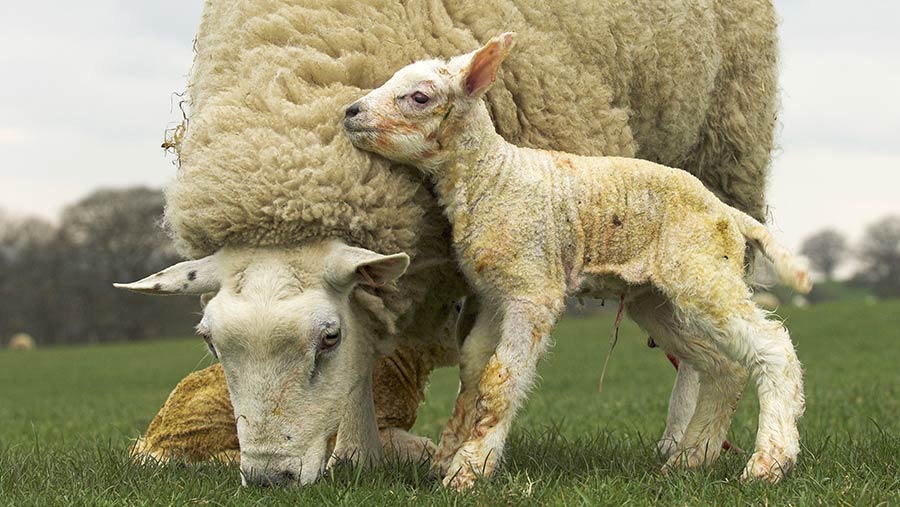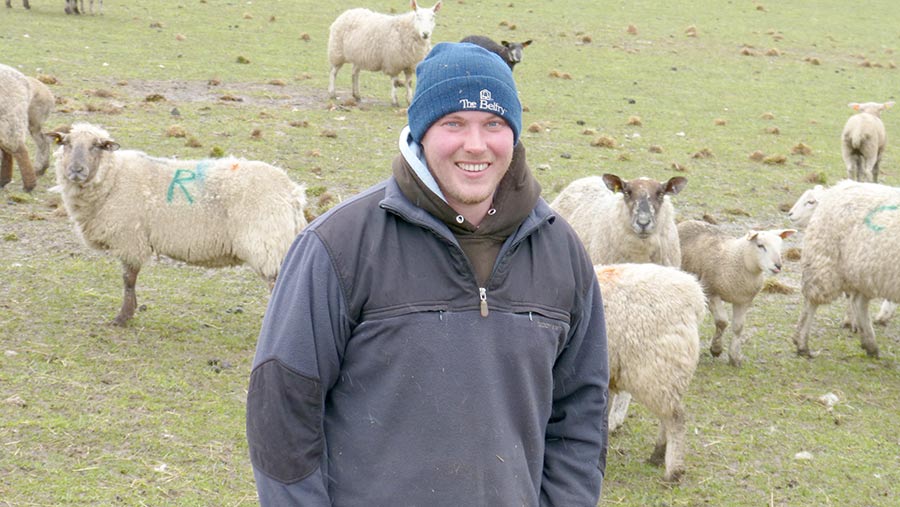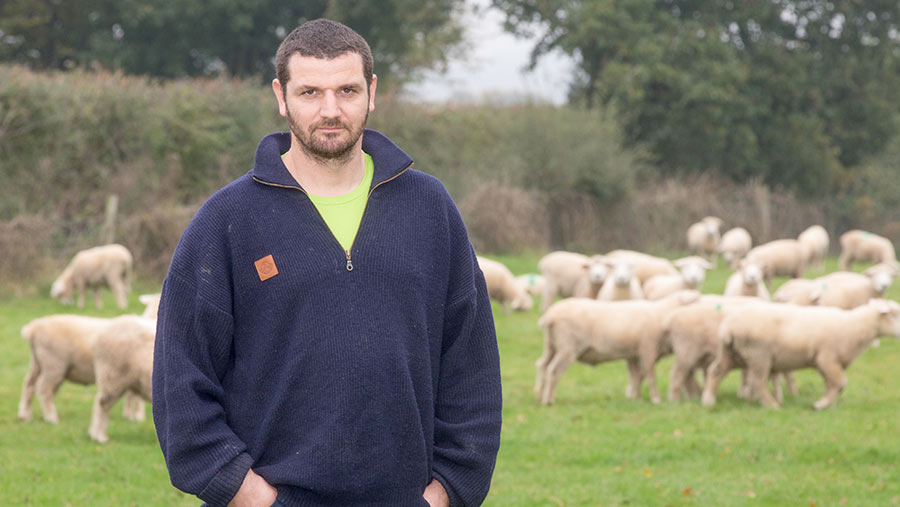13 tips for lambing outdoors
 © Food and Drink/Shutterstock
© Food and Drink/Shutterstock Outdoor lambing done with the right breeds, approach and at the optimal time of year can help farms lower costs in their sheep systems.
Farms lambing outdoors rely heavily on the weather, but lambs can benefit from being born and reared in the outdoors, with fewer pathogens than a lambing shed.
Productivity can often be lower than when compared to indoor lambing, but both systems can perform well.
Farmers Weekly asks three sheep breeders how they lamb outdoors and what they do to ensure it works.
See also: How a farmer tackled watery mouth without antibiotics
James Drummond, Lemmington Hill Head, Northumberland

Lambing facts
- Lambing 1,560 Innovis ewes including ewe lambs (1,040 Aberfield ewes and shearlings; 110 Abertex shearlings, 300 Aberfield ewe lams, 110 Abertex and Aberdale ewe lambs)
- Single sire mating for one cycle with sweeper rams used after a cycle. Replacements are only kept from those getting pregnant in the first cycle. The rest go into the B flock.
- All A and B flock lambs are tagged and recorded at birth.
- Does not feed any supplements after lambing as it can cause mis-mothering.
- Two-to-three day staff and one at night
- Land – 220ha – with dedicated lambing fields close to home. Most fields are split up into 2ha paddocks for rotational grazing.
- Lambing April-May in a five-week block. Ewes are synchronised.
- Scanning targets: ewes 195%; shearlings 175% and ewe lambs 125%
- Losses: 12% from scanning to weaning
1. Set up your grazing
Adequate pasture availability at the point of lambing is key, according to Mr Drummond.
He says if ewes don’t have grass in front of them (target being 2400kg DM/ha) they will spend more time searching for grass and less time bonding with lambs.
Ewe lambs and ewes are wintered on more exposed land, which includes fodder beet, a kale and swede mix and plantain.
In the run-up to lambing, they are moved on to more sheltered ground closer to the farm.
Mr Drummond has installed 10km of fencing in the past year alone to reduce paddock sizes down to about 2ha each. The aim is to make rotational grazing simpler and improve pasture quality.
He also makes sure each paddock has good access to water, especially in bigger fields.
Ewes are moved into pastures further away to graze after lambing.
Once they have been on the new pasture for a few days the ewes are then mobbed up into larger groups after a few days and start rotational grazing.
Mob size and rotation length is determined by pasture growth.
2. Select for the correct sheep
The Aberfield is a maternal breed which is essential when lambing outdoors.
Mr Drummond selects ewes that lamb unassisted, have good body condition, maternal behaviour and colostrum. These are factors that are recorded at birth.
Having a maternal ewe also means there are very few pet lambs. It also means that when there are any pet lambs, they can be fostered onto another ewe.
Hoggs can rear two lambs and ewes and shearlings can rear three.
3. Leave ewes and lambs to bond
During lambing Mr Drummond spends much of his time in the lambing fields checking ewes so records can be taken as soon after lambing as possible and parentage verified.
Ewes and lambs are left to bond for at least 30 minutes after lambing.
Once ewes have finished licking lambs and the lambs have been seen sucking they are gathered into a quad trailer to have their data recorded.
4. Data recording
Good data recording is essential to maintain breeding records as DNA parentage is too expensive (in excess of £55,000).
Ewes and lambs are gathered as soon as possible after lambing and routine data collection is undertaken. This consists of:
- Tagging with two tags
- Tailing
- Navels sprayed with an iodine solution to prevent joint ill
- Weighed
- The lamb’s sex, weight, lamb vigour score, lambing ease score, and cover scoring are recorded into a handheld Psion device.
- Ewes are scored on her body condition, maternal behaviour and colostrum.
By day Mr Mr Drummond and one other worker continuously check sheep recording data all day with the Psion.
Ewes are housed at night to ensure parentage is verified, with pens used to keep lambs mothered up.
Any lambing problems are noted in a book and transferred into the Psion in the morning to ensure nothing is missed.
Mr Drummond says even if farmers are not data recording electronically, they can still do it easily by marking the ewes.
“Any problem ewes just mark them with an ear notch or spray so you can easily identify the ones you need to get rid of. Poorer performing ewes will be costing you time and money,” he says.
5. Buy good tyres
Good tyres on the quad bike are essential, especially in wet conditions.
Rob Hodgkins, Kaiapoi, Hertfordshire

© Tim Scrivener
Lambing facts
- Lambing 2,200 New Zealand Romneys outside
- Lambing paddocks spread out
- Stocking singles at 4.5-5 ewes/acre, twins at 3-3.5 ewes/acre and triplets lamb on lucerne or high-quality pasture
- Scanning 170-175% (excluding ewe lambs)
- Weaning 155-165%
- Retaining 250 of 400 ewe lambs produced by the elite flock as replacements, 170 of which go into the commercial flock. 30 rams are retained from the elite flock each year.
6. Get ewes in the correct body condition score (BCS)
Getting ewes in the correct body condition is key. All ewes are overwintered outside on oat plants and stubble turnips from November.
They come off the lambing field in September/October and do not go back in until 15 March.
Ewes are scanned in February, with foetus size and the number of lambs recorded. The singles are fed a maintenance diet, grazed on rough parkland pasture and have a target BCS of 2.5-3.
Twins have a target BCS of 3 and get better grazing and any remaining stubble turnips and oats.
For the triplets the target BCS is 3.5. Because energy can be an issue, triplets are given the best grazing land and a mineral block.
7. Make sure data identifies good mothers
All sheep are EID recorded and DNA sampled. Triplet-bearing ewes are kept closest to home and all ewes are checked twice a day during lambing.
Foetus size is measured in the elite flock at scanning, along with the number of lambs, to get a more accurate lambing date.
When combined with eight-week weight and weaning weight, this allows Mr Hodgkins to get a better idea of lamb growth and the maternal ability of the ewe.
All lambs in the elite flock are genomically tested, with the Romney currently the only breed with a full SNP chip dedicated to it.
The genomic data is used in breeding decisions alongside the other data that has been recorded.
Lamb mortality is also recorded at weaning. Mr Hodgkins adds: “We are not interested in when the lamb died, but if a ewe isn’t rearing her lambs we will not keep her in the elite flock.”
8. Breed the right ewe
The Romneys have been bred to require as little management input as possible.
The aim is to breed an easy-care sheep, reared on forage, which is resistant to worms, is structurally correct and can lamb outside with little intervention.
9. Provide shelter
Shelter in lambing fields provides a desirable place for ewes to lamb. However, if there is only a small area of cover provided, all the ewes will choose to lamb there.
This increases the potential for diseases such as joint ill.
Where fields are hedged, ewes may seek shelter and bury themselves into a hedge bottom, causing a lot of damage in the process.
To avoid incurring penalties under environmental scheme rules, it can be worth putting up fencing to prevent hedge damage occurring, says Mr Hodgkins.
10. Provide adequate water
Mis-mothering can be caused when there are not enough water troughs in a field. Mr Hodgkins says:
“If you’ve got a 90-acre field with only one trough, for example, you will get mis-mothering issues as the ewe will go in search of water and will return to find her lamb has gone.”
11. Educate the public
With several footpaths running through the farm, the team takes steps to educate the public about outdoor lambing.
Facebook is used to tell dog walkers that the Kaiapoi team check the sheep twice daily and pick up any problems with ewes or lambs.
People are told to leave sheep alone and keep dogs on a lead.
“We also educate a few friendly dog walkers who disseminate the information to their friends.
“For anyone wanting to educate the public I wouldn’t recommend putting your phone number out there but rather set up a separate email for lambing queries,” he says.
Bobby Lennox, Shantron Farm, Loch Lomond

Lambing facts
- Lambing 400-500 Scottish Blackface, non-recorded, single-bearing ewes outside
- Farming up to 2,275ft above sea level, 100in of rainfall a year
- Lambing over 61ha (150 acres) of rough grazing
- Using EBVs to select easy lambing, maternal ewes since the mid 1980s
- Starts lambing 20 April
- 5% mortality in outdoor lambers between birth and weaning
- Three members of staff at lambing time
- Scanning at 110-120%
- Open to the public for lambing experience tours every day throughout lambing
12. Use performance recording to choose the right genetics
Mr Lennox only lambs single-bearing ewes from the commercial non-performance recorded flock outside.
He says the single lambs tend to be stronger and there is less chance of mis-mothering.
The 600 to 700 recorded and twin-bearing ewes lamb indoors so Mr Lennox can check both lambs are being fed.
Having the maternal capabilities to support a lamb outside is important. The Lennox’s have been selecting for maternal traits for many years. Specifically:
- Milkiness
- Lamb survival
- Muscle depth of lamb
- Eight-week weight of lambs (which gives an indication of how well the ewe has milked)
Only non-performance recorded animals lamb outside as data collection would be too hard.
13. Let the ewes and lambs get on with it
The ewes are left to lamb outside with no supplementary feed given. Mr Lennox can go three to four days without seeing a ewe after lambing.
Lambs are tagged at about two to three weeks of age and any missed will be tagged at the first gather during shearing time in July.
The ewes and lambs are not touched until then. Navels are not dipped.
